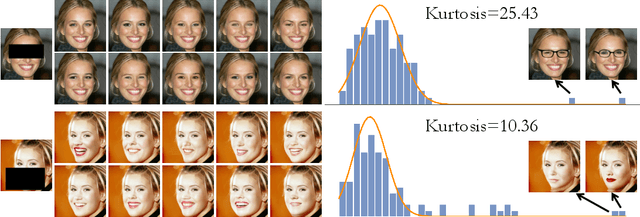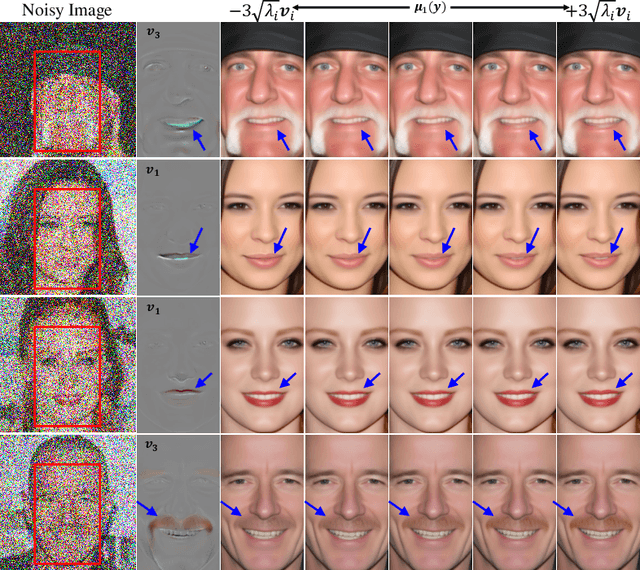Hila Manor
When Diffusion Models Memorize: Inductive Biases in Probability Flow of Minimum-Norm Shallow Neural Nets
Jun 23, 2025Abstract:While diffusion models generate high-quality images via probability flow, the theoretical understanding of this process remains incomplete. A key question is when probability flow converges to training samples or more general points on the data manifold. We analyze this by studying the probability flow of shallow ReLU neural network denoisers trained with minimal $\ell^2$ norm. For intuition, we introduce a simpler score flow and show that for orthogonal datasets, both flows follow similar trajectories, converging to a training point or a sum of training points. However, early stopping by the diffusion time scheduler allows probability flow to reach more general manifold points. This reflects the tendency of diffusion models to both memorize training samples and generate novel points that combine aspects of multiple samples, motivating our study of such behavior in simplified settings. We extend these results to obtuse simplex data and, through simulations in the orthogonal case, confirm that probability flow converges to a training point, a sum of training points, or a manifold point. Moreover, memorization decreases when the number of training samples grows, as fewer samples accumulate near training points.
Compressed Image Generation with Denoising Diffusion Codebook Models
Feb 04, 2025



Abstract:We present a novel generative approach based on Denoising Diffusion Models (DDMs), which produces high-quality image samples along with their losslessly compressed bit-stream representations. This is obtained by replacing the standard Gaussian noise sampling in the reverse diffusion with a selection of noise samples from pre-defined codebooks of fixed iid Gaussian vectors. Surprisingly, we find that our method, termed Denoising Diffusion Codebook Model (DDCM), retains sample quality and diversity of standard DDMs, even for extremely small codebooks. We leverage DDCM and pick the noises from the codebooks that best match a given image, converting our generative model into a highly effective lossy image codec achieving state-of-the-art perceptual image compression results. More generally, by setting other noise selections rules, we extend our compression method to any conditional image generation task (e.g., image restoration), where the generated images are produced jointly with their condensed bit-stream representations. Our work is accompanied by a mathematical interpretation of the proposed compressed conditional generation schemes, establishing a connection with score-based approximations of posterior samplers for the tasks considered.
Zero-Shot Unsupervised and Text-Based Audio Editing Using DDPM Inversion
Feb 25, 2024Abstract:Editing signals using large pre-trained models, in a zero-shot manner, has recently seen rapid advancements in the image domain. However, this wave has yet to reach the audio domain. In this paper, we explore two zero-shot editing techniques for audio signals, which use DDPM inversion on pre-trained diffusion models. The first, adopted from the image domain, allows text-based editing. The second, is a novel approach for discovering semantically meaningful editing directions without supervision. When applied to music signals, this method exposes a range of musically interesting modifications, from controlling the participation of specific instruments to improvisations on the melody. Samples and code can be found on our examples page in https://hilamanor.github.io/AudioEditing/ .
From Posterior Sampling to Meaningful Diversity in Image Restoration
Oct 24, 2023



Abstract:Image restoration problems are typically ill-posed in the sense that each degraded image can be restored in infinitely many valid ways. To accommodate this, many works generate a diverse set of outputs by attempting to randomly sample from the posterior distribution of natural images given the degraded input. Here we argue that this strategy is commonly of limited practical value because of the heavy tail of the posterior distribution. Consider for example inpainting a missing region of the sky in an image. Since there is a high probability that the missing region contains no object but clouds, any set of samples from the posterior would be entirely dominated by (practically identical) completions of sky. However, arguably, presenting users with only one clear sky completion, along with several alternative solutions such as airships, birds, and balloons, would better outline the set of possibilities. In this paper, we initiate the study of meaningfully diverse image restoration. We explore several post-processing approaches that can be combined with any diverse image restoration method to yield semantically meaningful diversity. Moreover, we propose a practical approach for allowing diffusion based image restoration methods to generate meaningfully diverse outputs, while incurring only negligent computational overhead. We conduct extensive user studies to analyze the proposed techniques, and find the strategy of reducing similarity between outputs to be significantly favorable over posterior sampling. Code and examples are available in https://noa-cohen.github.io/MeaningfulDiversityInIR
On the Posterior Distribution in Denoising: Application to Uncertainty Quantification
Sep 24, 2023



Abstract:Denoisers play a central role in many applications, from noise suppression in low-grade imaging sensors, to empowering score-based generative models. The latter category of methods makes use of Tweedie's formula, which links the posterior mean in Gaussian denoising (i.e., the minimum MSE denoiser) with the score of the data distribution. Here, we derive a fundamental relation between the higher-order central moments of the posterior distribution, and the higher-order derivatives of the posterior mean. We harness this result for uncertainty quantification of pre-trained denoisers. Particularly, we show how to efficiently compute the principal components of the posterior distribution for any desired region of an image, as well as to approximate the full marginal distribution along those (or any other) one-dimensional directions. Our method is fast and memory efficient, as it does not explicitly compute or store the high-order moment tensors and it requires no training or fine tuning of the denoiser. Code and examples are available on the project's webpage in https://hilamanor.github.io/GaussianDenoisingPosterior/
 Add to Chrome
Add to Chrome Add to Firefox
Add to Firefox Add to Edge
Add to Edge